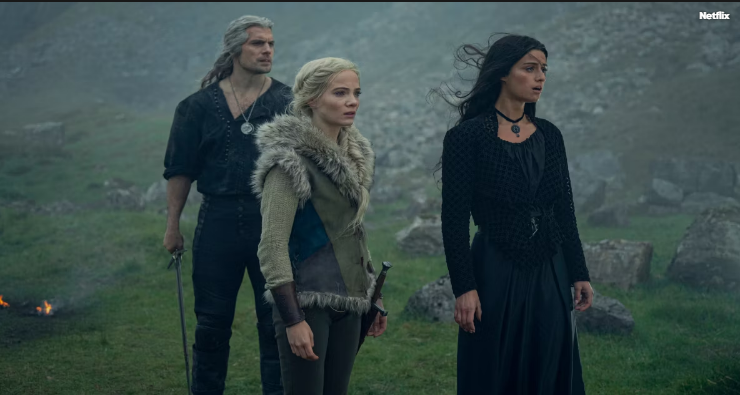The Biggest Detail Netflix’s The Witcher Gets Wrong

Despite its many, many changes, there is one glaring issue in The Witcher’s translation of the original books.
Netflix’s adaptation of The Witcher has received a very mixed reception from audiences and critics. Those without prior knowledge of the franchise have mostly enjoyed the series as a dark fantasy drama with decent action sequences and interesting characters. However, fans of the source materials – be it Andrzej Sapkowski’s lorded series of books or CDProjektRed’s acclaimed video game trilogy – have heavily critiqued the show as a weak adaptation filled with problems and needless changes.
From its first season, The Witcher had already begun to make major alterations to plot lines and characters from the books. Some of these changes were small, aesthetic details, like the Dryads of Brokilon Forest, whose green skin was changed for natural human colors. Others were far larger, like conceptualizing an entire backstory for Anya Chalotra’s Yennefer, when part of what makes her character so interesting is the enigma surrounding her past.
The Witcher Is Too Reductionist

Despite what the show presents, The Witcher books aren’t non-stop action fests with ballads and monster fight after monster fight. Instead, The Witcher source material is a slow-burn, character-focused drama set in a dark fantasy world with far more long conversations and monologues than frequent battles. The gray morality of its characters was always the primary focus of the books, and any fantasy elements acted as accompaniments.
There have been a lot of complaints about Season 3, but the most common is the quality of the writing. Season 3 has swapped the in-depth explorations of its characters’ psyches for an action-orientated melodrama. While that is enough to make hardcore fans of the source material frustrated, a consequence of this change of story flow is that the individual characters are given less time to develop and are instead reduced to their most basic characteristics.
Episode 5 of the new season – unsubtly titled “The Art of the Illusion” – has received the overwhelming majority of this season’s criticism thanks to its drastic and unnecessary changes from the source material. The episode sees Geralt and Yennefer infiltrate the Conclave Ball at Aretuza to uncover and bring down the mage that has been conducting inhumane experiments on girls.
The episode takes the style of a suave spy thriller that plays with multiple timelines to slowly peel away the mystery of Geralt and Yen’s detective work. In its attempt to do something different, the episode removes any depth and subtlety from one of the most intriguing scenes from the books.
The Conclave Ball from Time of Contempt – the book that Season 3 attempts to adapt – gives readers a deeper exploration into the morals and motivations of the main mages and sorceresses, like Kiera Metz, Philippa Eilhart, and, most importantly, Vilgefortz (who has a much larger role to play in the grander story).
Instead of the long conversation Geralt has with these characters in the books, Netflix’s adaptation strips almost all of them away in favor of its stylized but simplistic mystery. As a result, the large majority of the mages are reduced to 2D caricatures of their original characters, with any complexity regarding their morals stripped back to simply good and evil.
Despite some of the changes, Season 1, for the most part, translated this well. Adapting The Last Wish (the first book in the series, which is actually a collection of short stories) gave the show the leeway to fully explore the psychology of its characters, as the structure felt more like an intertwined anthology than a traditional linear series.
However, as the seasons progressed, and Netflix moved from the two collections of short stories – The Last Wish & Sword of Destiny – into the main novels in the series, it also transitioned into a straightforward linear narrative. While this, by itself, is in no way a bad thing as it is the appropriate way to tell such a story, it is how Netflix has handled the source material, by reducing it to its most basic elements, that is the show’s biggest problem.
Netflix Promised Season 3 Would Be More Faithful

When adapting any medium to another, there will always have to be some changes to conform the narrative to its new medium. The long, multi-page conversations and monologues found in The Witcher books would never work as pure adaptations as they would drastically hamper the narrative’s pacing and actively work against the golden rule of visual storytelling: ‘Show, Don’t Tell.’
In response to the criticism of the changes found in Seasons 1 & 2, showrunner Lauren S. Hissrich, via Collider, promised that Season 3 would be a more faithful adaptation. In some ways, this is true. Season 3 does, more or less, follow the key plot points of the books, including Geralt joining Yarpen Zigrin’s convoy (although this is from Blood of Elves), Ciri’s exploration of Gors Velen, and the Conclave Ball. However, Season 3 alters key events and characters within these scenes and even creates entirely new plot lines tacked on to the adapted story.
The most glaring example of this in Season 3 is the evil mage sub-plot that leads to Geralt and Yennefer exposing Stregabor’s inhumane experiments. To start, Vilgefortz only makes one brief appearance in the books when he appears in the short story ‘The Lesser Evil,’ which was adapted in the show’s pilot episode.
Netflix has changed Stregabor’s importance in the story from being a small secondary character to a much larger antagonist. The problem with this change is that it doesn’t improve upon The Witcher’s main plot or even enhance any themes the show tries to explore. It is simply tacked on as a new story.
Only the first part of Season 3 has been released so far. However, most fans expect these narrative changes to continue into the final three episodes, as the plot’s forward trajectory now has these unnecessary changes instilled in its core.




